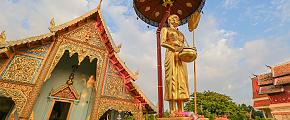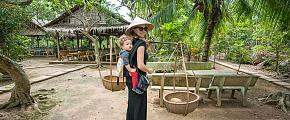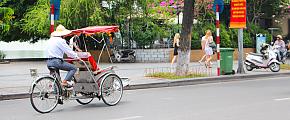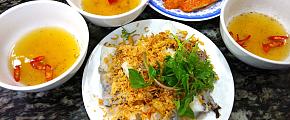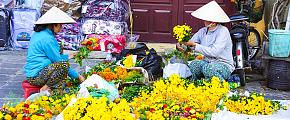Vietnam Travel Tips | Things You Need to Know
When traveling abroad, it is necessary to follow the manners and customs of the country. Overall, Vietnam does not have strict religious and social rules, but knowing what you should or shouldn't do will help you avoid misunderstandings and inconveniences. In this article, you will find tips on weather, visa, manners, customs on various occasions, and several facts concerning hygiene and safety.
When to Visit Vietnam?
The best time to visit each area of Vietnam may differ based on different weather conditions. Therefore, we are going to demonstrate to you when to visit each area of Vietnam separately.
North: Hanoi, Halong Bay, etc.
The best time to travel to the northern area of Vietnam such as Hanoi is during the dry season from October to April. Especially from November to February is highly recommended due to the significant reduction of humidity for you to spend the time more comfortably.
 Halong Bay Cruise
Halong Bay Cruise
Center: Hoi An, Da Nang, Hue, etc.
The best season to visit the central regions of Vietnam is during the dry season from February to July. Especially from June to July, the temperature is high, so you can wear short sleeves even at night. Although, be careful with the strong sunlight in this season.
South: Ho Chi Minh, Dalat, Nha Trang, etc.
When you plan to travel to the southern regions of Vietnam such as Ho Chi Minh City, it is recommended to visit during the dry season from November to April. If you're planning to visit Ho Chi Minh City, we recommend January to February, when it's relatively cool.
Visa for Vietnam
Whether you need to apply for a visa to enter Vietnam depends on your nationality and the length of your stay. Due to the agreement Vietnam has made with some countries, if you are from the countries listed below, you can enter Vietnam without a visa for a certain length of period.
14 days: Brunei, Myanmar
21 days: The Philippines
30 days: Cambodia, Indonesia, Laos, Malaysia, Singapore, Thailand
45 days: Belarus, Denmark, Italy, Japan, Finland, France, Germany, Norway, Russia, South Korea, Spain, Sweden, The United Kingdom
90 days: Chile, Panama
If your country is not listed above, or you would like to stay more than the given length of stay, there are 2 types of visa you can apply for.
One is called E-Visa, which you can apply for online easily and get your visa within 3 working days. With E-Visa, you are allowed to stay in Vietnam for up to 90 days and you can enter with it from any international airport or seaport.
The other visa you can apply for as a tourist is Visa On Arrival. This type of visa allows you to stay in Vietnam for up to 12 months with a single entry or multiple entries. If you would like to pick up your visa at the airport of Vietnam, you have to contact your local travel agency to obtain a visa approval letter from the Vietnamese Immigration Department which will be asked for at the airport. With this type of visa, you can only enter from the airports listed below:
Noi Bai International Airport (Hanoi) Tan Son Nhat International Airport (Ho Chi Minh) Cam Ranh International Airport (Nha Trang) Da Nang International Airport (Da Nang) Cat Bi International Airport in (Hai Phong) Phu Quoc International Airport (Phu Quoc Island)
Things You Need to Know When Visiting Temples
1. Avoid Afternoon Breaks Time
The first thing to note before planning a tour of the temples of Vietnam is the time of day you are visiting. Most Buddhist temples close for a lunch break between 12:00 and 1:30. Therefore, try to visit at a different time if it is possible. Also, remember that photography using flash is also prohibited during this time.
2. Avoid Wearing Clothes with Much Exposure
Another important thing you should note is to avoid clothing that reveals a lot of skin. For religious reasons, people with exposed skin may not be allowed to enter the temple. Just in case, it's recommended to bring long sleeves and long pants if you plan to visit temples in Vietnam.
 Buu Long Pagoda in Vietnam
Buu Long Pagoda in Vietnam
Things You Need to Know When Shopping at the Local Market
In every city in Vietnam, it is easy to find a local market that sells multiple types of goods. Some markets also became famous tourist attractions. If you plan to visit some of these local markets, here are a few things you should note.
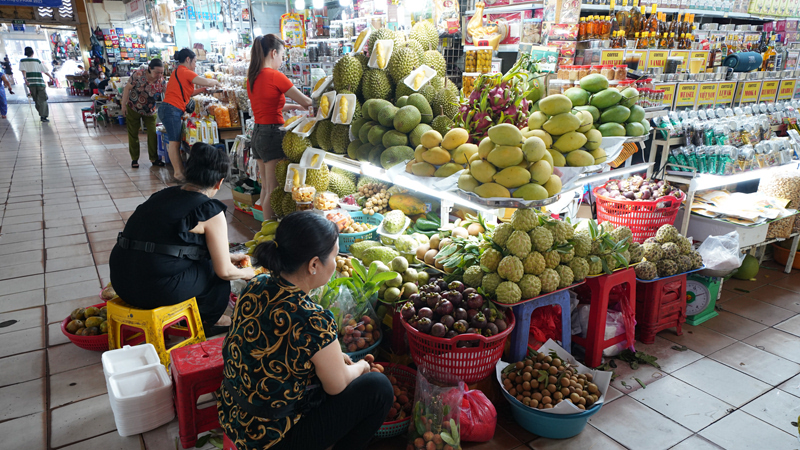 Local Market in Vietnam
Local Market in Vietnam
1. Compromise in Price Negotiations with Sellers
Price negotiations are very common in the local markets since the merchants usually ask for a high price at the beginning. It is natural that the seller will try to sell it at a high price, but it is not a crime here where there is no fixed price. However, price negotiations here are all about finding a compromise that both sides can agree on. If you just express your opinion and keep pushing to get a good price, the seller may get angry and in the worst case develop into trouble between you two. Therefore, when you negotiate in local markets, always remember to compromise with manners.
2. Avoid Touching the Product Carelessly
Some products in the local market may seem curious and you just can't help to touch them. But for several reasons, please avoid touching the product carelessly. First of all, there is a risk that you may break the goods if you drop them on the floor. And since there is no fixed price, the seller may ask you for a very high price. Secondly, some sellers may also ask you to buy the products you have touched.
Things You Need to Know at the Restaurant
In restaurants in Vietnam, there are no particular table manners or customs to be aware of. Here are some tips for avoiding minor misunderstandings while dining in Vietnam.
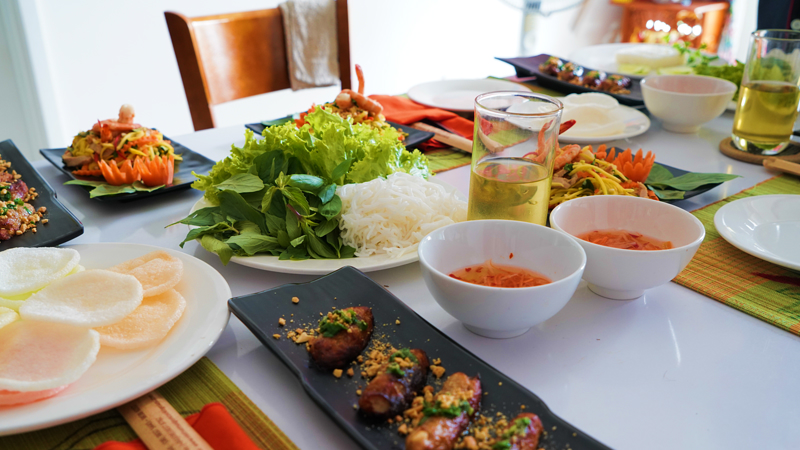 Vietnamese Dishes
Vietnamese Dishes
1. Tea and Wet Tissues are Charged with an Extra Fee
In Vietnamese restaurants, towels and wet tissues for cleaning your hands are basically charged extra. They usually come out automatically or are placed on the table from the beginning. You may also find cold tea called Chadda in the restaurant, but normally it is charged and can be ordered by any number of people.
2. Leaving Tips is Optional but Welcomed
In general, tipping is not required when serving Vietnamese locals. However, it may be required in luxury hotels, taxis, local tours, and bars for tourists. For example, tips for hotel bed making is about 20,000 dong. When tipping, there is no regulation such as a 10% fee like in other countries and basically, 20,000 to 30,000 dong as tips should be enough.
3. Always Check Out at the Table
In every country, where you check out may be different. In some countries, you bring your receipt to the cash register. While in Vietnam, you always pay at the table in all restaurants, from casual to fine dining. And if you stand up from your seat without paying the bill, you may be mistaken for eating while walking. When you're done eating, you can just raise your hand and call the waiter saying "Check", "Bill", etc.
Things You Need to Know about Public Transportation
1. Always Give Your Seat to the Elderly
In Vietnam, it is important to respect elders in many aspects. Being polite to the elders and especially giving seats to the elders has become one of the common manners of Vietnamese.
2. Always Carry Small Change
The bus fee in Vietnam is very cheap, even if you take a bus from the starting station to the terminal station, it costs only 5,000 to 6,000 dong. Many tourists may carry lots of banknotes with them, but in fact, most of the time the staff from the bus doesn't have the right amount of change to give you back. If you plan to travel by bus in Vietnam, remember to always carry small change.
Things You Need to Know about Hygiene
1. Avoid Drinking Tap Water
Many travelers may wonder if they can drink Vietnamese tap water. It can also be used for gargling and brushing teeth, but we do not recommend using it as drinking water. When you need to drink water, it is always better to buy mineral water from shops than drink tap water. By the way, most of the ice used in drinks at restaurants comes from ice factories that are safe to drink.
2. Always Carry Toilet Paper with You
Most toilets in Vietnam are flush toilets, but toilet paper cannot be flushed. Toilet paper may be left outside the toilet, so if you don't have toilet paper with you, check if there is toilet paper before entering the room. And remember to throw it in the trash bin after use to avoid the toilet getting clogged. Besides hotels and restaurants, there are many toilets that don't provide toilet paper in Vietnam. Therefore, it is recommended to always carry toilet paper with you just in case.
The tips and suggestions we introduced above covered most of the occasions you may encounter in Vietnam. Please be aware of them according to your travel plan. If you would like to get a comprehensive and comfortable Vietnam travel plan, feel free to contact our travel specialists to customize your entire journey to Vietnam fully based on your preferences.

